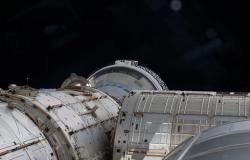Hear
Saturn’s icy moon Enceladus is considered one of the most tempting places to look for extraterrestrial life because of the liquid oceans that “slosh” beneath its frozen surfaces.
Of course, getting there is a difficult task not only because of the millions of kilometers that separate us from Enceladus, but also because it is a place impossible to explore with the classic four-wheeled rover. With this premise, NASA scientists presented a particular snake-shaped robot.
This is the EELS (Exobiology Extant Life Surveyor or, in Spanish, Exobiological Existing Life Finder), which was developed to reach inaccessible places and find possible forms of life. The robot has already demonstrated its ability to traverse narrow spaces and descend vertically between ice shafts, a landscape similar to what it would have to face on Enceladus. The place chosen to carry out these tests was the Athabasca Glacier, in Canada.
The robot, which seems to crawl like a snake, It has a head equipped with cameras and sensors, including a laser-based system that creates maps of its environment, in the same way that self-driving cars can map the world. The body of the robot is made up of individual modules linked together that can house scientific instruments. It also has spiral connectors throughout the body to propel the robot forward.
The autonomy of EELS is also evidenced by the fact that can make independent decisions without human interaction. Otherwise, due to the delay between communications between Earth and space, you would have to wait hours to solve an urgent problem.
Designed by the Jet Propulsion Laboratory (JPL), The robot has 48 motors in the different modules from one end to the other. “It has the ability to go places other robots can’t go,” explained Matthew Robinson, a JPL scientist and member of the EELS research and development team. “Although some robots are better at one specific type of terrain or another, the idea with EELS is the ability to explore them all,” he concluded.
With toothed wheels that allow you to get grip on difficult surfaces, The team has been working on the robot since 2019. Currently, EELS weighs around 100 kilos and is 4 meters long.
Along with NASA, several universities such as Arizona State University, Carnegie Mellon University and the University of California, San Diego participated in the development. While the elegant design and versatility of EELS are inspired by the desire to move through tight, explosive spaces on Enceladus, Its engineers imagine versions of the robot to also explore cave-like structures on the Moon where astronauts can find shelter or explore further to reach areas of the Earth itself..
“There are dozens of textbooks on how to design a four-wheeled vehicle, but There is no textbook on how to design an autonomous snake robot to boldly go where no robot has gone before.”said EELS principal investigator Hiro Ono. “We have to write our own. “That is what we are doing now,” they noted.
Once he Exobiology Extant Life Surveyor is in an optimal state to advance its mission, NASA would send it to Saturn via spacecraft in approximately twelve years.
THE NATION






